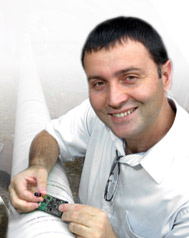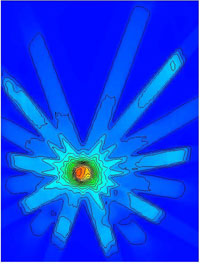About LANL
About Our Capabilities, Facilities, and Staff
"Los Alamos National Laboratory plays an indispensable role in building America as a science and technology powerhouse, and our staff are an incredible resource to the nation and the world." Michael Anastasio, Dir.
Solving Complex R&D Problems with Special Blend of Staff, Capabilities and Facilities
Now in its seventh decade, LANL remains among a very few laboratories that can bring great breadth of fundamental and discovery science, technology, and engineering rapidly together to create tangible solutions for national security needs.
Our staff, working with partners throughout science and industry, must be able to deliver today's solutions while maintaining the depth of capabilities to deliver the next generation of discoveries.
Los Alamos has demonstrated a cycle of innovation where we have developed world-leading capabilities and facilities in response to urgent, unique missions. We also spin out new discoveries that lead to emerging missions.
Being able to integrate and apply our capabilities rapidly to new challenges will be a key advantage in an increasingly competitive landscape.
Our Science, Technology and Engineering Priorities
Science that Matters
- Information science and technology enabling integrative and predictive science
- Experimental science focused on materials for the future
- Fundamental forensic science for nuclear, biological, and chemical threats
How We Work
- Collaborate, partner and team to make decisive contributions to our sponsors
- Outstanding operational excellence for safety, security, and efficient pursuit of ST&E for our missions
Transform Our Scientific Campus
- Campus for 2020 (consistent with complex transformation)
- Modern science facilities: LANSCE refurbishment, CMR replacement, Science Complex
- Signature facilities for experimental science (MaRIE) and computational science (Roadrunner)
More About This Science
Solving mathematical Equations Governing Subatomic Particle Behavior
Cancer Therapy Saves Lives
Acuros software provides unrivaled speed, accuracy for radiation treatment

Quick read
The efficiency of cancer treatment is now increased thanks to new software that has unrivaled speed and accuracy for predicting radiation behavior, saving healthy cells.
Cancer treatment's efficacy—largely due to how quickly the cancer is removed—has increased thanks to new software with unrivaled speed and accuracy, saving healthy cells.
The application, called Acuros, predicts radiation behavior. For radiotherapy dose calculations, Acuros uses an accurate representation of the patient's anatomy, obtained from computed tomography scans or magnetic resonance imaging, to directly solve the mathematical equations governing subatomic particle behavior.
Acuros is developed by Transpire, Inc., a Los Alamos spin-off company and exclusive licensee of the Attila software.
"Transpire is a great spin-off success story for the Laboratory. Not only are they selling a very impressive commercial software based on Los Alamos technology, they are further developing that technology to branch out into other markets," said John Mott of the Technology Transfer Division at Los Alamos. "Spin-off companies are another way for Los Alamos to transfer technology into private industry, creating new jobs and boosting the economy."
A central challenge in radiotherapy is to deliver high doses of radiation to the entire tumor site without damaging surrounding organs and tissues. Dozens of dose calculations may be required to develop a single, optimized radiotherapy-treatment plan.
Plans are developed on hospital computers with physicians or physicists anticipating nearly immediate results, requiring almost real-time dose calculation speed.
To meet these speed demands, most dose calculation methods in use today use simplifications that compromise accuracy. With Acuros providing accurate information more quickly, physicians are able to properly develop and interactively apply better patient-specific treatment plans, raising success rates and reducing complications.
Acuros will initially support photon-beam radiotherapy and brachytherapy (a type of radiotherapy). Proton therapy and targeted radionuclide therapies will be added later.
Acuros and Monte Carlo (computational algorithms) solve the same equations through different methods: Acuros, deterministically; Monte Carlo, stochastically. Acuros combines the accuracy of Monte Carlo with the speed of approximate methods.
According to Transpire, Acuros is free of statistical noise, enabling the effects of small treatment planning perturbations to be accurately and rapidly assessed. Acuros also offers an unrivaled spatial precision, where millimeter resolution can be locally realized at critical areas, such as in build-up regions or near heterogeneities, without significantly increasing dose calculation times.
Former Los Alamos scientists John McGhee and Todd Wareing, together with Gregory Failla and Allen Barnett, launched Transpire, Inc., with the intention of commercializing Attila. Based in Gig Harbor, Washington, Transpire, Inc., now addresses industry applications as diverse as radiation shielding, medical imaging, homeland security, and reactor analysis.

Ayyorgun breeds wireless nodes
Self-organizing sensor network research wins award
Wireless sensor networks soon may allow engineers to wirelessly monitor miles of gas and oil pipelines, rescue workers to detect signs of life under rubble, and monitor illicit trafficking and intrusions on international borders . . .
Currents, the Laboratory's monthly employee magazine, highlighting people in the workplace.








